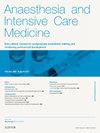Intrauterine fetal resuscitation
IF 0.3
Q4 ANESTHESIOLOGY
引用次数: 0
Abstract
Oxygen transport from the atmosphere to the fetus is dependent on maternal, placental and fetal factors. If any of these are disturbed, progressive fetal hypoxia and acidosis occur. Electronic fetal heart rate (FHR) monitoring is considered the primary method to assess fetal condition. Fetal distress refers to the presence of a non-reassurance heart trace, irrespective of the presence or absence of fetal acidosis. Intrauterine fetal resuscitation (IUFR) is a practice designed to enhance oxygen delivery to the placenta and maintain umbilical blood flow to counteract fetal hypoxia and acidosis, enabling safe delivery. IUFR measures might include: (i) re-positioning of the parturient to left lateral or alternative to relieve aortocaval compression; (ii) reducing uterine contractions by stopping oxytocics and using tocolytics (iii) correcting maternal hypotension and maximizing uterine blood flow via rapid intravenous crystalloid infusion; and (iv) maternal oxygen administration to reduce fetal hypoxaemia. IUFR measurements are simple to implement, do not need extensive resources and can lead to considerable improvements in fetal health. Anaesthetists play a pivotal role in IUFR and should be familiar with the process as they will be actively involved in the management of parturient during labour and before emergency surgical interventions.
宫内胎儿复苏
氧气从大气输送到胎儿取决于母体、胎盘和胎儿的因素。如果其中任何一项受到干扰,就会发生进行性胎儿缺氧和酸中毒。电子胎儿心率(FHR)监测被认为是评估胎儿状况的主要方法。胎儿窘迫是指存在一个不放心的心脏痕迹,无论胎儿酸中毒的存在与否。宫内胎儿复苏(IUFR)是一种旨在增强胎盘供氧和维持脐带血流量以对抗胎儿缺氧和酸中毒,实现安全分娩的做法。IUFR措施可能包括:(i)将产妇重新定位到左侧或替代位置,以减轻主动脉腔静脉压迫;(ii)通过停用催产剂和使用抗早产药物来减少子宫收缩(iii)通过快速静脉滴注晶体来纠正产妇低血压和最大化子宫血流量;(四)母体给氧减少胎儿低氧血症。IUFR测量实施简单,不需要大量资源,可显著改善胎儿健康。麻醉师在IUFR中起着关键作用,他们应该熟悉这一过程,因为他们将在分娩期间和紧急手术干预前积极参与产妇的管理。
本文章由计算机程序翻译,如有差异,请以英文原文为准。
求助全文
约1分钟内获得全文
求助全文
来源期刊

Anaesthesia and Intensive Care Medicine
ANESTHESIOLOGY-
CiteScore
0.50
自引率
0.00%
发文量
152
期刊介绍:
Anaesthesia and Intensive Care Medicine, an invaluable source of up-to-date information, with the curriculum of both the Primary and Final FRCA examinations covered over a three-year cycle. Published monthly this ever-updating text book will be an invaluable source for both trainee and experienced anaesthetists. The enthusiastic editorial board, under the guidance of two eminent and experienced series editors, ensures Anaesthesia and Intensive Care Medicine covers all the key topics in a comprehensive and authoritative manner. Articles now include learning objectives and eash issue features MCQs, facilitating self-directed learning and enabling readers at all levels to test their knowledge. Each issue is divided between basic scientific and clinical sections. The basic science articles include anatomy, physiology, pharmacology, physics and clinical measurement, while the clinical sections cover anaesthetic agents and techniques, assessment and perioperative management. Further sections cover audit, trials, statistics, ethical and legal medicine, and the management of acute and chronic pain.
 求助内容:
求助内容: 应助结果提醒方式:
应助结果提醒方式:


